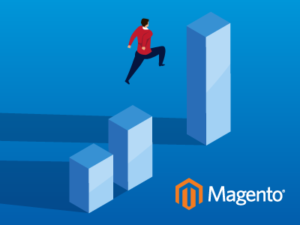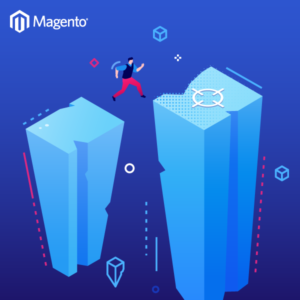
Better performance and scalability! Streamlined checkout! More mobile-friendly and better content management! B2B enhancements!
Chances are you’ve already heard about all the new and improved features Magento 2 (M2) has over Magento 1 (M1). Maybe you’ve even started to add your favorite Amazon features to your new Magento 2 site Wishlist. You’ve been hearing for the past year that Magento is ending M1 support in June 2020 and you’re ready to step on the gas pedal and just build your M2 site.
We get it, we’re excited to dive in too. But before you start loading up your Jira backlog with all the user stories for features in your M1 store, take this time to plan and prioritize. The next few months aren’t going to be a simple migration from M1 to M2 by conventional standards; it’ll be a re-platform. Don’t worry, you’ll be able to carry forward most of the logic, refactor custom functionality, and installations of the 3rd party extensions you had in M1 to M2. Just be aware that you can’t just assume this will be easy! Keep in mind possible roadblocks such as wanting a different look and feel from Luma or rebuilding M1 customizations that can’t be refactored in M2. This is where your MVP (minimum viable product) comes in to play.

As long as you are going to do a major re-platform, this is a great time to holistically assess your ecommerce business and customer needs. Where are you currently with your KPIs and where do you want to be? Can you quantify what that growth should look like? What are the most valuable aspects of your site? What differentiates you from your competitors? How’s the industry trending? Who are your customers and what are they looking for? What’s working well and what’s not? What is the customer journey like today and how do you want to improve it? Start writing these things down. You’ll want these notes handy as you begin thinking about your minimum viable product, or your MVP. The MVP is defined as, “…the version of a new product which allows a team to collect the maximum amount of validated learning about customers with the least effort.” Basically, it’s agile speak for doing a lot with little!
Many of us grew up thinking more is more, not less is more. Let’s start thinking less is more, especially for software development. Focus on the minimum required to go live (MVP). “How soon can I launch my site?” “How soon can I start making money off of my new site?” For this reason (and others), we suggest not blindly migrating “everything” that existed in your M1 store and going straight to development to “save costs”. If you take this approach, you will likely not save costs in the long run. (not to mention you might also be wasting money on things you don’t actually need)

To get started, here are a few things to consider as you begin defining your MVP (this is just the tip of the iceberg):
- Have you walked through your entire M1 site (both the frontend and backend) recently? Make a test purchase and note how that goes.
- Are you still using all your 3rd party extensions? Are some working better than others? To the extent possible, consider purchasing all M2 extensions from the same reputable company, as this decreases the likelihood of incompatibility between installed modules.
- Do you have any backend integrations? For example: PIM, ERP, Order Management, Shipping. Could you launch without any of them, at least at first?
- How often do customers abandon their cart? Are people actually clicking on the ‘Add to Cart’ button on your product listing pages? Are people using the compare products functionality? Find out by looking at Google Analytics. Understanding your current user engagement is critical.
- Have you seen how Magento 2 looks and works out-of-box? If not, find a demo site and poke around. Take note of what you like and don’t like. Keep in mind – seemingly small changes like tweaking the cart, checkout, customer account, etc. can quickly add up! Figure out what out-of-box elements you can live with for launch and what can be deferred.
- Are you relatively up-to-date with security patches and upgrades? If not, the effort needed to move to Magento 2 may be more complex.
- How are your customizations working today? Are they working well, or do you find yourself logging support tickets often? This may be a good time to clean up custom functionality and reduce some of the technical debt you’ve accumulated over the past few years. This may increase the development cost of your upgrade, but the benefits gained (i.e. reduction of maintenance costs down the road) will outweigh the cost.
- Does your site look slick and modern? If not, it may be time to refresh your site design (at least your home page and mobile site, given M2’s improved mobile responsiveness over M1).
- Think about each piece of custom functionality. Do you still need it? Does it drive enough revenue to warrant keeping the customization, if it costs you a lot to rebuild it in M2?
All this information will feed into the tough decisions you’ll need to make regarding your MVP. Organize your features using some logical groupings (ex: homepage, product detail page, product listing page, search, global elements, purchasing experience) and utilize prioritization tactics such as MoSCoW (Must-have, Should-have, Could-have, Won’t have) to help delineate what’s critical and what’s nice-to-have. This doesn’t need to be fancy; use Excel or Google Sheets.

We are far from advocating analysis paralysis. Our point is, take some time to think about your users. What are the most important features for your customers (both external and internal)? What are the features that drive the most revenue through your site? Take the time to plan properly. Take a phased approach. Some merchants migrating from M1 assume all they really need to do is hire a few developers and dive straight into M2 development. Don’t do this. Please. Be mindful about what you really need and how much you really need to launch a first version under M2. Remember, your MVP is NOT the end. It’s only the beginning.
One of the great benefits of an ecommerce platform like Magento is its modular nature. Once you get your foundation up and running and start getting customer feedback, you can almost always add the bells and whistles later. Adopting this mentality will increase the likelihood that you get the highest return on your investment and launch your site on time and on budget. This may also create room in your budget to kick off better marketing and content creation efforts, which are both integral to a well-rounded ecommerce strategy.



